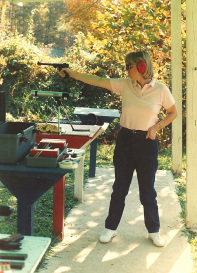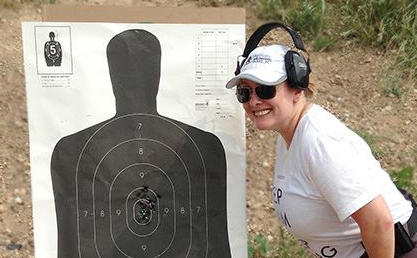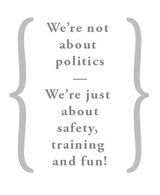ARCHIVE - ISSUE TWO - JUNE 2013 - FEATURE PICTORIAL - TRAINING - LIFESTYLE - ARCHIVE - ISSUE TWO - JUNE 2013
The Girl Can't Help It [continued from cover story]

Another important thing for an instructor to understand and use, is that female students use those emotions during their interactions inside the class. A female student is much more likely to care about the instructor’s opinion of them and their progress in the course. While many males consider the instructor’s opinion of them to be a moot point, female students require a more one on one feel to training, and are much more appreciative of feedback while on the firing line.
To a male instructor, this is a foreign concept. Men are generally taught from a young age that emotion is to be avoided. As such, some instructors find it difficult to to “reach across the aisle,” so to speak, and connect with a student on a more personal level. But, simple things like calling a female student by name or by giving personalized feedback can do wonders for a female student’s confidence and her enjoyment of the course itself. Even a smile is a big help, as cheesy as it may sound. Male instructors must take caution not to overdo it however, for fear of sexual harassment allegations or even just being improperly perceived by the student.
Another key difference is the way that women process information. After all, the point of “instruction” is instructing, right? In order to be a successful instructor, you must know how your students learn, and be able to teach to that.
Details, details, details. While men are known to take in information at a high level, women are much better adapted to take information in at a much more detailed, granular level. Ive seen it time and time again. Look around at the students when you start spitting out extremely detailed information… Women perk up and men’s eyes start rolling back in their heads. For a coed classroom, finding the right balance is key. This can also be accomplished by a Q&A section after each section of material covered. For female only courses, the more information, the better.
Over the years, I’ve found exceptions to every rule. The differences between training males and females are no different. I’ve certainly trained women who broke the mold and defied everything that this article says. While modern thinking has instructors believing that we should train all students in the same manner, I disagree. Recognizing the differences between males and females is the right way to train.
P. Petersen is a law enforcement officer who is currently assigned to an investigative role. Former positions include Field Training Officer, DWI Unit and SWAT Sniper as well as Designated Marksman in both Iraq and Afghanistan as a civilian contractor.
To a male instructor, this is a foreign concept. Men are generally taught from a young age that emotion is to be avoided. As such, some instructors find it difficult to to “reach across the aisle,” so to speak, and connect with a student on a more personal level. But, simple things like calling a female student by name or by giving personalized feedback can do wonders for a female student’s confidence and her enjoyment of the course itself. Even a smile is a big help, as cheesy as it may sound. Male instructors must take caution not to overdo it however, for fear of sexual harassment allegations or even just being improperly perceived by the student.
Another key difference is the way that women process information. After all, the point of “instruction” is instructing, right? In order to be a successful instructor, you must know how your students learn, and be able to teach to that.
Details, details, details. While men are known to take in information at a high level, women are much better adapted to take information in at a much more detailed, granular level. Ive seen it time and time again. Look around at the students when you start spitting out extremely detailed information… Women perk up and men’s eyes start rolling back in their heads. For a coed classroom, finding the right balance is key. This can also be accomplished by a Q&A section after each section of material covered. For female only courses, the more information, the better.
Over the years, I’ve found exceptions to every rule. The differences between training males and females are no different. I’ve certainly trained women who broke the mold and defied everything that this article says. While modern thinking has instructors believing that we should train all students in the same manner, I disagree. Recognizing the differences between males and females is the right way to train.
P. Petersen is a law enforcement officer who is currently assigned to an investigative role. Former positions include Field Training Officer, DWI Unit and SWAT Sniper as well as Designated Marksman in both Iraq and Afghanistan as a civilian contractor.





















